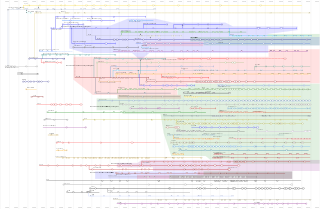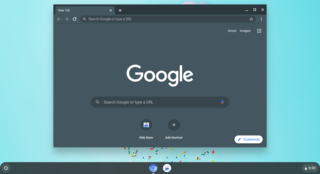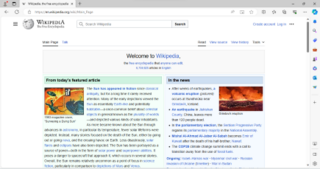Related Research Articles

Adware, often called advertising-supported software by its developers, is software that generates revenue for its developer by automatically generating online advertisements in the user interface of the software or on a screen presented to the user during the installation process. The software may generate two types of revenue: one is for the display of the advertisement and another on a "pay-per-click" basis, if the user clicks on the advertisement. Some advertisements also act as spyware, collecting and reporting data about the user, to be sold or used for targeted advertising or user profiling. The software may implement advertisements in a variety of ways, including a static box display, a banner display, full screen, a video, pop-up ad or in some other form. All forms of advertising carry health, ethical, privacy and security risks for users.

A browser war is a competition for dominance in the usage share of web browsers. The "first browser war," (1995-2001) pitted Microsoft's Internet Explorer against Netscape's Navigator. Browser wars continued with the decline of Internet Explorer's market share and the popularity of other browsers including Firefox, Google Chrome, Safari, Microsoft Edge and Opera.
Midori was the code name for a managed code operating system (OS) being developed by Microsoft with joint effort of Microsoft Research. It had been reported to be a possible commercial implementation of the OS Singularity, a research project begun in 2003 to build a highly dependable OS in which the kernel, device drivers, and application software are all written in managed code. It was designed for concurrency, and could run a program spread across multiple nodes at once. It also featured a security model that sandboxes applications for increased security. Microsoft had mapped out several possible migration paths from Windows to Midori. Midori was discontinued some time in 2015, though many of its concepts were used in other Microsoft projects.
Google Chrome is a cross-platform web browser developed by Google. It was first released in 2008 for Microsoft Windows, built with free software components from Apple WebKit and Mozilla Firefox. Versions were later released for Linux, macOS, iOS, and also for Android, where it is the default browser. The browser is also the main component of ChromeOS, where it serves as the platform for web applications.

Private browsing is a privacy feature in some web browsers. When operating in such a mode, the browser creates a temporary session that is isolated from the browser's main session and user data. Browsing history is not saved, and local data associated with the session, such as Cookies, Web cache, are cleared when the session is closed. These modes are designed primarily to prevent data and history associated with a particular browsing session from persisting on the device, or being discovered by another user of the same device.

Chromium is a free and open-source web browser project, mainly developed and maintained by Google. This codebase provides the vast majority of code for the Google Chrome browser, which is proprietary software and has some additional features. Chromium's logo is identical in shape to that of Google Chrome, but with blue colors instead of being multicolor.

ChromeOS, sometimes styled as chromeOS and formerly styled as Chrome OS, is a Linux-based operating system developed and designed by Google. It is derived from the open-source ChromiumOS and uses the Google Chrome web browser as its principal user interface.

ChromiumOS is a free and open-source operating system designed for running web applications and browsing the World Wide Web. It is the open-source version of ChromeOS, a Linux-based operating system made by Google.
Pwn2Own is a computer hacking contest held annually at the CanSecWest security conference. First held in April 2007 in Vancouver, the contest is now held twice a year, most recently in March 2023. Contestants are challenged to exploit widely used software and mobile devices with previously unknown vulnerabilities. Winners of the contest receive the device that they exploited and a cash prize. The Pwn2Own contest serves to demonstrate the vulnerability of devices and software in widespread use while also providing a checkpoint on the progress made in security since the previous year.

A Chromebook is a laptop or tablet running the Linux-based ChromeOS as its operating system. Initially designed to heavily rely on web applications for tasks using the Google Chrome browser, Chromebooks have since expanded to be able to run Android and full-fledged Linux apps since 2017 and 2018, respectively. All supported apps can be installed and launched alongside each other.
Microsoft Intune is a Microsoft cloud-based unified endpoint management service for both corporate and BYOD devices. It extends some of the "on-premises" functionality of Microsoft Endpoint Configuration Manager to the Microsoft Azure cloud.
HomeOS was the working title of a home automation operating system being developed at Microsoft Research in the early 2010s. Microsoft Research announced the project in 2010 and abandoned it in 2012.

Microsoft Edge is a proprietary, cross-platform web browser created by Microsoft. It was first released in 2015 as part of Windows 10 and Xbox One and later ported to other platforms as a fork of Google's Chromium open-source project: Android and iOS, macOS, older Windows versions, and most recently Linux. Edge was created as the successor to Internet Explorer (IE).
Windows 10 has several editions, all with varying feature sets, use cases, or intended devices. Certain editions are distributed only on devices directly from an original equipment manufacturer (OEM), while editions such as Enterprise and Education are only available through volume licensing channels. Microsoft also makes editions of Windows 10 available to device manufacturers for use on specific classes of devices, including IoT devices and previously marketed Windows 10 Mobile for smartphones.
Microsoft, a technology company historically known for its opposition to the open source software paradigm, turned to embrace the approach in the 2010s. From the 1970s through 2000s under CEOs Bill Gates and Steve Ballmer, Microsoft viewed the community creation and sharing of communal code, later to be known as free and open source software, as a threat to its business, and both executives spoke negatively against it. In the 2010s, as the industry turned towards cloud, embedded, and mobile computing—technologies powered by open source advances—CEO Satya Nadella led Microsoft towards open source adoption although Microsoft's traditional Windows business continued to grow throughout this period generating revenues of 26.8 billion in the third quarter of 2018, while Microsoft's Azure cloud revenues nearly doubled.
Azure Virtual Desktop (AVD), formerly known as Windows Virtual Desktop (WVD), is a Microsoft Azure-based system for virtualizing its Windows operating systems, providing virtualized desktops and applications securely in the cloud. It is aimed at enterprise customers rather than at individual users.

CBL-Mariner is a free and open-source Linux distribution that Microsoft has developed. It is the base container OS for Microsoft Azure services and the graphical component of WSL 2.
Comparison of user features of operating systems refers to a comparison of the general user features of major operating systems in a narrative format. It does not encompass a full exhaustive comparison or description of all technical details of all operating systems. It is a comparison of basic roles and the most prominent features. It also includes the most important features of the operating system's origins, historical development, and role.
References
- ↑ "The Multi-Principal OS Construction of the Gazelle Web Browser" (Microsoft Research whitepaper, PDF)
- 1 2 3 4 "Gazelle: Applying Operating System Concepts to the Browser" OSNews July 7, 2009
- ↑ Foley, Mary Jo (11 March 2011). "Microsoft's ServiceOS: A potential piece of Microsoft's cloud play, post-Windows 8". ZDnet. Retrieved 22 April 2018.
- ↑ Foley, Mary Jo (23 February 2009). "Microsoft's MashupOS leaps like a Gazelle". ZDnet. Retrieved 22 April 2018.
- 1 2 "Microsoft's Gazelle browser takes a radical path" CNet July 7, 2009
- ↑ "Google’s Chrome OS vs. Windows" The Week July 8, 2009
- ↑ "Google Chrome OS: is it copying Microsoft's Gazelle or is it more like Splashtop?" The Guardian July 8, 2009
- ↑ Resource Management for Web Applications in ServiceOS
- ↑ Foley, Mary Jo (26 May 2010). "ServiceOS: Microsoft's morphing browser-operating system project". ZDnet. Retrieved 21 April 2018.
- ↑ Foley, Mary Jo (2 December 2015). "Microsoft plans to add containers to Windows client, too". ZDnet. Retrieved 21 April 2018.
- ↑ Newman, Jared (29 April 2015). "'Project Spartan' no more: Microsoft's new browser is called Edge". PCWorld. IDG. Retrieved 22 April 2018.